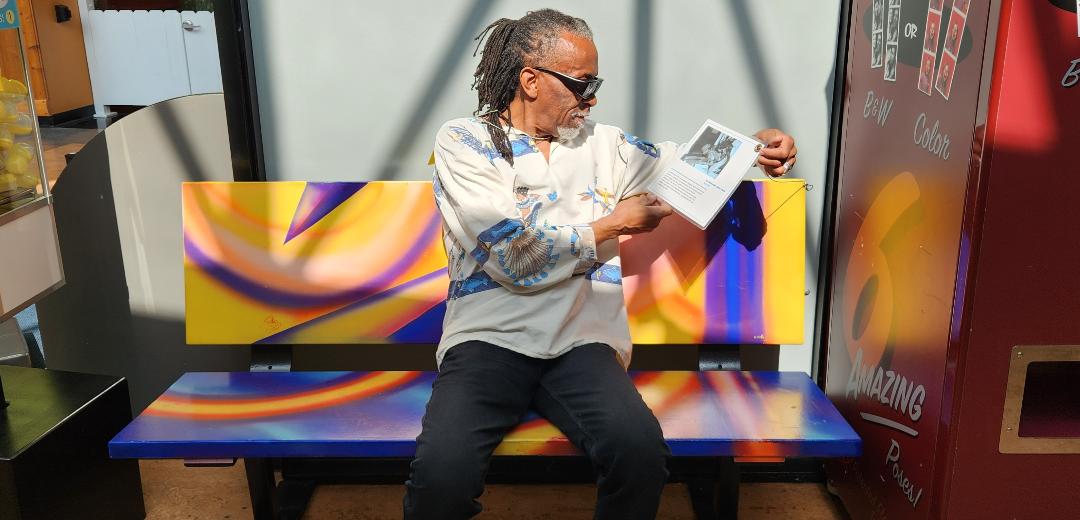"Being that I draw left-handed doing this work that progresses in all directions needs care. Per the painting:
"Fear No Maskings" Acrylics on 24" X 36" paneling.
"She may be distraught but not fearful for as she leaves her walk
through the Valley of Death, she wore her mask". Please share whenever
or where ever!
I coined the term Rhythmistic after I made a discovery in 6th grade that I was channeling designs and images via a genetic memory that was future-primitif in effect and result. I noticed this when my teachers scolded me for doodling along the entire length of a sheet of spelling paper during a test.
Though I spelled each word correctly, she gave me an "F' for the doodles. I was excited when I saw them. I thought, "That is it! This is me! This is my style". I have been operating out of those pathways every since that day in 1963.
Below is an excerpt from and article that covers aspects of my spontaneous discover as a child. This foundation of my decades practice that is often challenged and ridiculed by orthodox, jealous, bigoted or insecure types of folks in the arts communities. Be they my former instructors, gallery curators, critics and the like. I know they refuse me and that fact of my being a young Black child making such a brilliant connection. Decades later I saw white Artists empowered and valued and given credit for similar efforts and expressions.
But that is the politics of the global Visual Arts Industrial Complex and its policy of Blacks being passionate and instinctive and Whites being intelligent and mindful. Thus rendering a logic that Blacks could never conceive of launching a genre in the Visual Arts.
Well I launched Rhythmism. Just Wiki my name to learn more about it.
So later I learn about Carl Jung's theories and research. And I thought,,,,"See....See....this is what I have been saying and doing all along. "
Now while I do not endorse the over-hyped and erroneously valued amature-like works of the non-Black artists mentioned in the article, I think if sums up my premise.
Rhythmism as being future-primitif be accessing genetic memory's pathways via the visual arts practice.
Art in times of coronavirus
LONDON.-
According to the Cambridge dictionary, art is the crafting of objects,
images, music, or indeed any manifestation that is beautiful and
expresses feeling. Artists feel deeply, and with the help of a brush, a
pen, an instrument or their natural vocal chords, they can create a
unique piece of art. As an independent art consultant, I have been
exposed to many different artworks throughout my career. What’s more, I
was fortunate enough to discover the great stories behind these
artworks, personally recalled by the artists themselves. I often asked
myself: what, if anything, do all artworks have in common? Do they share
any similarities or motivations? To answer my question, we may refer to
the likes of Carl Jung.
Carl Jung (1875 - 1961) was a Swiss psychiatrist and psychoanalyst,
who once studied the human psyche - an area that is both mystical and
stimulating for psychologists and soulsearchers alike. Jung proposed the
idea that a segment of the deepest unconscious mind is genetically
inherited, and not at all shaped by personal experience. Rather, a
collective experience is passed down by man and lives on in each and
every one of us - a notion that he coined “the unconscious mind”. It
means that we, as humans, share an innate library of knowledge and
instinct - feelings like joy, love, fear and sadness. This mutual
collection of knowledge and instinct is what unites us as a species.
“A child that is born tomorrow contains the whole history of the human race within his body and within his mind.” (Jung)
Vis-à-vis art, Jung proposed that a work of art is a culmination of
human experience, and an artwork is sometimes unknowingly guided by the
deep feelings and thoughts that exist within us. When we create art, we
are communicating in ways that we are not completely aware of.
This could indicate that there are artistic impulses, permeating throughout history.
Jung’s explanation for this, is that symbols and known images are
deeply rooted in the history of mankind. This rings true for the stick
figures depicted in the artworks of both Penck and Haring. We
automatically associate these stick figures with the shape of people
because they are reminiscent of our own bodily form. Similarly, Grayson
Perry evaluated art created by prisoners and was astounded by the number
of eagles, tigers and freedom symbols that arose. As for art created
during Coronavirus, meaningful symbols can be expected. Symbols are
significant because they evoke a feeling without using any words.
During the first days of lockdown, I spoke to many collectors,
artists, friends and family members; everyone shared their deepest
feelings with me. Some felt disconnected, sad, dissatisfied and lonely,
whilst others surrendered themselves to something higher - something
that was fortunately or unfortunately (depending how you perceive
things) out of their control. They were finally able to escape the
demands and hectic tempo of everyday life, and instead started to truly
see and feel again. The beauty of nature, the pleasure of peace and
quiet and the results of inner contentment. Nonetheless, we shared a
common underlying feeling - fear of the unknown. We saw the impact of
Coronavirus on our individual and collective health, social lives and
economy. As an art advisor, I was particularly interested in how my
network of artists felt during such testing, turbulent times.
This could indicate that there are artistic impulses, permeating throughout history.
by Julia Campbell Carter








